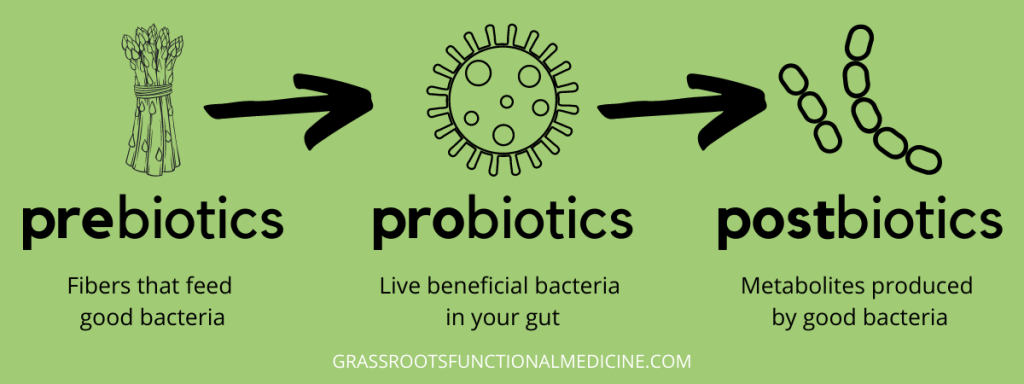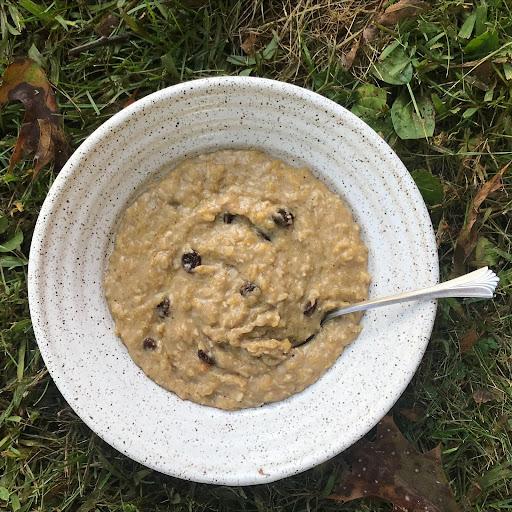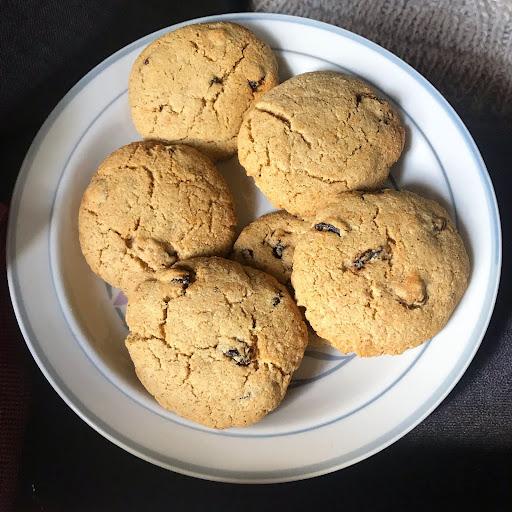You probably know about probiotics, the beneficial bacteria that support gut health, immune function, mood balance and so much more. But are you familiar with their super-powered precursors – prebiotics?
These special fibers are found in certain plant foods and selectively feed the friendly bacteria in your gut. In this article, I’ll break down what prebiotics are (including resistant starch), why they matter for your health, and the best ways to incorporate them into your diet.
What are Prebiotics?
Prebiotics are defined as fibers that are not digested and absorbed in the stomach or small intestine but instead travel down into the large intestine, where they selectively feed beneficial strains of intestinal microflora. They are sometimes referred to as microbiome fertilizer.
The good bacteria they feed in turn produce short chain fatty acids (known as postbiotics), which nourish the cells of the GI tract, leading to better gut lining integrity, immunity, and nutrient absorption.

Types of Prebiotics
There are three types of prebiotics: non-starch polysaccharides such as inulin and fructooligosaccharides, soluble fiber (i.e. psyllium), and resistant starch. The last of these, resistant starch, isn’t technically a fiber, but it “resists” normal digestion like other prebiotics and makes its way to the colon to feed gut bacteria.
Resistant starch type 2 (RS2) is found in raw potatoes, green bananas, and raw plantains but becomes digestible when these foods are cooked. The form of resistant starch that is easiest to get in the diet is resistant starch type 3. RS3 forms in starchy foods like potatoes and rice when they are cooked and then cooled.
Benefits of Prebiotics
Gut Health
Prebiotics have a big role to play when it comes to proper digestion. In order for beneficial gut bacteria to thrive and perform their important functions, they need to be well fed with prebiotics. Butyrate (named after butter, which is also a source) is a short-chain fatty acid that is produced by bacteria. It is like rocket fuel for your intestinal cells. Increasing prebiotics in the diet will increase the levels of buyrate in the colon, and you can get additional butyrate through a high-quality postbiotic supplement.
When the cells lining the intestine are healthy, they can do a better job of selectively opening their tight junctions to allow nutrients from food to pass into the bloodstream while preventing pathogens, endotoxins, or undigested food particles from entering and triggering an immune reaction (a scenario known as “leaky gut”). Better gut lining integrity means better absorption, and increasing prebiotics has been shown to increase your body’s ability to utilize nutrients like calcium and magnesium.
Blood Sugar Regulation
Another benefit of prebiotics is that they help to moderate blood glucose spikes after eating carbohydrates and can even improve the sensitivity of cells to insulin and promote weight loss. Test subjects who ate a muffin high in resistant starch had lower blood sugar readings than the people eating regular muffins.
This may be particularly helpful for patients with thyroid disease or adrenal dysfunction since poor blood sugar spikes can worsen both of those conditions. Resistant starch supplementation has also been shown to reduce fasting glucose levels and decrease total and LDL cholesterol.
Are Prebiotics Right for Everyone?
Clearly, there are many benefits from upping the prebiotics in your diet, from improved nutrient absorption to lower blood sugar levels. However, there are certain populations who may want to exercise caution when introducing more prebiotics.
Since the function of prebiotics is to feed bacteria, people suffering from an overgrowth of bacteria in the small intestine (know as SIBO, Small Intestinal Bacterial Overgrowth) may experience a worsening of their symptoms like gas, bloating, and discomfort if they consume a lot of prebiotic-rich foods. In fact, a commonly recommended dietary approach for SIBO is a low-FODMAP diet, which specifically restricts foods that contain easily fermentable fibers. This doesn’t mean that prebiotics are bad, just that the gut needs to be in a healthy, balanced state in order to benefit from them. If it’s out of balance, it may be best to temporarily avoid eating a lot of prebiotics. This is where personalized guidance from your functional medicine provider can be helpful.
The Best Sources of Prebiotics
There are prebiotic supplements out there, but the team at GrassRoots believes it makes the most sense to get prebiotics and resistant starch from eating real whole foods rather than spending money on more nutraceuticals. The more vegetables, fruits, and properly prepared grains and legumes you eat, the more prebiotic fibers you will get in your diet.
Foods High in Prebiotics:
- Apples
- Asparagus
- Cassava
- Garlic
- Jerusalem artichoke
- Leeks
- Legumes
- Onions
- Oats
- Tigernuts
- Underripe bananas
- Whole husk psyllium
Foods High in Resistant Starch:
- Cooked and cooled potatoes
- Cooked and cooled rice
- Beans and legumes
- Raw potato starch
- Green bananas and plantains
How to Incorporate Prebiotics Into Your Diet
- Add green bananas to smoothies
- Snack on tigernuts
- Add raw garlic to hummus or pesto
- Add raw onion and asparagus to salads
- Batch cook potatoes and rice to eat as leftovers
- Fry green plantains in coconut oil
- Make soaked oatmeal
- Make oatmeal muffins
- Make tortillas with cassava flour
AIP and Paleo Recipes Rich in Prebiotics

Ingredients
- 1 large plantain
- ¾ c. full fat canned coconut milk
- 1 ½ c. water
- ¼ tsp salt
- ½ tsp ground cinnamon
- ¼ c. raisins
- 3 Tbsp RootFix Paleo Protein (optional)
Instructions
- To peel plantain, slice in half crosswise, then slice in half lengthwise and remove peel by sliding your thumb under the peel starting at the cut edge.
- Grate the plantain on a box grater.
- Place in a medium saucepan with the coconut milk and water. Cover, bring to a boil, reduce heat and simmer, stirring frequently. Cook for about 25 minutes, removing the cover for the last 10 minutes and continuing to stir.
- Stir in salt, cinnamon, raisins, and protein powder if desired.
- Serve with toppings such as chopped pear, berries, coconut flakes, or additional coconut milk.

Ingredients
- 1 c. (4 oz) tigernut flour
- 1 tsp baking soda
- ¼ tsp salt
- 1 oz collagen powder
- 3 Tbsp (1.5 oz) coconut butter
- 2 Tbsp (1 oz) coconut oil
- ¼ c. (2 oz) maple syrup
- 1 tsp vanilla
- ⅓ c (2 oz) raisins
- 2 tsp water (if needed)
Instructions
- Combine the dry ingredients in a bowl.
- Melt the coconut oil and butter together and stir in the maple syrup and vanilla. Add to the dry ingredients and combine until a dough forms, adding the water if needed.
- Mix in the raisins.
- Roll the dough into 14 balls and flatten into cookie shapes. Place on a parchment-lined cookie sheet.
- Bake for 12 mins at 350 degrees. Allow to cool before removing from cookie sheet.
20 Free AIP & Paleo Batch Cooking Recipes
 Along with simple tips to make meal prepping and batch cooking work for you, this book will also give you 20 recipes to mix and match for endless meal possibilities.
Along with simple tips to make meal prepping and batch cooking work for you, this book will also give you 20 recipes to mix and match for endless meal possibilities.
Inside, you’ll find delicious favorites your whole family will love, including:
- Creamy Mushroom Pasta
- Pesto Veggie Noodles
- Date Protein Bars
- and more!

About the Author: Lili Hanft is a certified Functional Nutritional Therapy Practitioner. She is passionate about the power of real food to support the body’s innate ability to heal, and she believes that nourishing ourselves with nutrient-dense foods can be a profound source of joy and empowerment.
Want to work with the GrassRoots team? Check out our Adaptation Program and book your free discovery call to find out if you’re the right fit.





